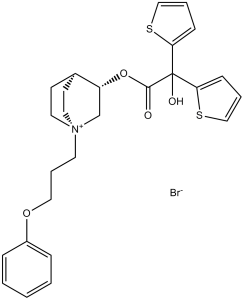This product is for research use only, not for human use. We do not sell to patients.

| Size | Price | Stock |
|---|---|---|
| 250mg | $750 | Check With Us |
| 500mg | $1150 | Check With Us |
| 1g | $1725 | Check With Us |
Cat #: V1194 CAS #: 320345-99-1 Purity ≥ 98%
Description: Aclidinium Bromide (formerly LAS34273, LAS-W 330; brand names Tudorza Genuair; Eklira Genuair; Bretaris Genuair) is a potent, long-acting and inhalable muscarinic antagonist used as a maintenance treatment for chronic obstructive pulmonary disease (COPD).
Publications Citing InvivoChem Products
Product Promise

- Physicochemical and Storage Information
- Protocol
- Related Biological Data
- Stock Solution Preparation
- Quality Control Documentation
| Molecular Weight (MW) | 564.55 |
|---|---|
| Molecular Formula | C26H30NO4S2.Br |
| CAS No. | 320345-99-1 |
| Storage | -20℃ for 3 years in powder formrr |
| -80℃ for 2 years in solvent | |
| Solubility In Vitro | DMSO: 113 mg/mL (200.15 mM)rr |
| Water: <1 mg/mLrr | |
| Ethanol: <1 mg/mL | |
| Solubility In Vivo | 30% PEG400+0.5% Tween80+5% Propylene glycol: 30 mg/mL |
| Synonyms | LAS 34273, LAS W 330; LAS-34273, LAS-W 330; LAS34273, LASW 330; trade name: Eklira Genuair; Tudorza Genuair; Bretaris Genuair |
| Protocol | In Vitro | Preclinically, aclidinium showed potent antagonism of human muscarinic receptors, with a long residence time at M3 receptors and a shorter residence time at M2 receptors, indicating the potential to provide sustained bronchodilation. Aclidinium is rapidly hydrolysed in human plasma, unlike other currently available antimuscarinics including tiotropium. Early clinical studies in healthy subjects have confirmed the low systemic bioavailability and favourable safety profile of single and multiple doses of aclidinium. In a subsequent Phase IIb study, which included 464 patients with moderate to severe COPD, aclidinium displayed long-lasting bronchodilatory activity and was well tolerated. |
|---|
| Solvent volume to be added | Mass (the weight of a compound) | |||
|---|---|---|---|---|
| Mother liquor concentration | 1mg | 5mg | 10mg | 20mg |
| 1mM | 1.7713 mL | 8.8566 mL | 17.7132 mL | 35.4264 mL |
| 5mM | 0.3543 mL | 1.7713 mL | 3.5426 mL | 7.0853 mL |
| 10mM | 0.1771 mL | 0.8857 mL | 1.7713 mL | 3.5426 mL |
| 20mM | 0.0886 mL | 0.4428 mL | 0.8857 mL | 1.7713 mL |
This equation is commonly abbreviated as: C1 V1 = C2 V2
- (1) Please be sure that the solution is clear before the addition of next solvent. Dissolution methods like vortex, ultrasound or warming and heat may be used to aid dissolving.
- (2) Be sure to add the solvent(s) in order.




































